Table of contents
- Review of the Tourist Trophy 1939 Race, facts & Legends
- Militarily charged language
- Racing license as a control instrument
- Racing 1939: private sector versus state dirigism
- In 1938, Meier failed after a few hundred meters
- Jimmy Guthrie and the TT that he could no longer experience
- Damage to the rear axle of his Norton brought Guthrie down
- Confusion about the trophy
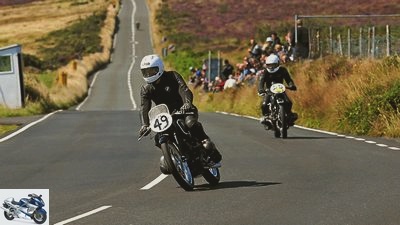
Kneen
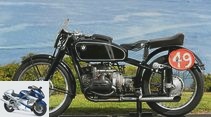
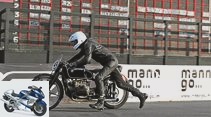
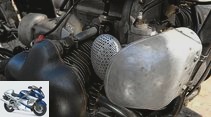
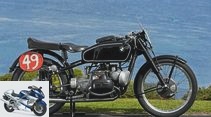
8th pictures

markus-jahn.com
1/8
After his failure in 1938, Schorsch Meier had an unfinished business.
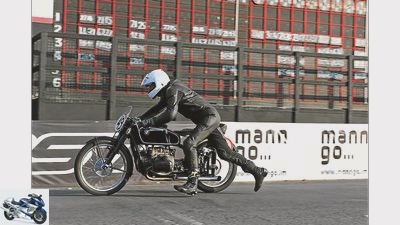
markus-jahn.com
2/8
For the photo, Wolfgang Meier, Schorsch Meier’s nephew, simulated sliding starts.

markus-jahn.com
3/8
The aluminum windshield protects the individual carburettors from icing up, and the magnesium valve cover was painted to protect against corrosion.
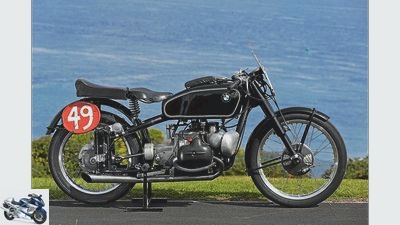
markus-jahn.com
4/8
Details such as rims and handlebar fittings are no longer original.
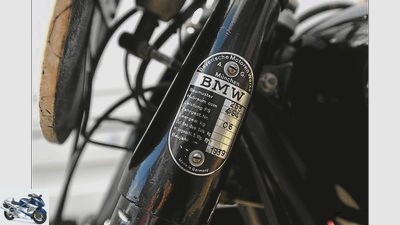
markus-jahn.com
5/8
The compressor BMW with the frame number 06 is the last one that essentially shows the status of 1939.
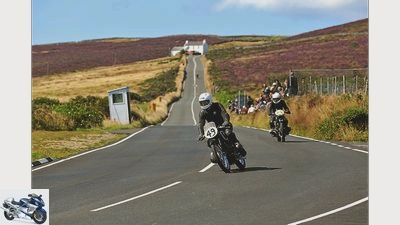
Kneen
6/8
Wolfgang Meier at Creg-ny-Baa, behind a BMW R 63, the author follows in the blur.

markus-jahn.com
7/8
The works BMW was by far the lightest motorcycle in the 1939 Tourist Trophy.
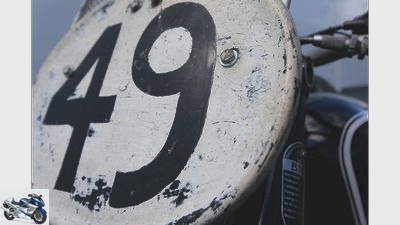
markus-jahn.com
8/8
George “George” Meier started the race with starting number 49.
Sports & scene
Motorsport
Review of the Tourist Trophy 1939
Review of the Tourist Trophy 1939
Race, facts & Legends
Content of
In September 2014, MOTORRAD editor Ralf Schneider was allowed to drive the “Lap of Honor” at the Classic TT. On a BMW R 51 SS to celebrate the 75th anniversary of Schorsch Meier’s TT victory. All the British he spoke to on the Isle of Man are relaxed about this anniversary. But other tones also sound in English historiography. They give cause to straighten things out.
Ralf Schneider
05.12.2014
The BMW double victory of Georg “Schorsch” Meier and Jock West in the Senior Tourist Trophy 1939 hurt the British. That can be stated without malice. This senior TT was the first in which neither a British or Irish driver nor a British motorcycle was involved in the victory. The second place of her compatriot Jock West apparently offered little consolation. This fact apparently pains a few British people to this day, because they keep a very special combination of truths, half-truths and mere legends alive with revisionist intentions.
Buy complete article
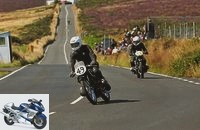
Review of the Tourist Trophy 1939
Race, facts & Legends
8 pages) as PDF
€ 2.00
Buy now
This attitude is manifested to the utmost in Roger Willis ‘book “The Nazi TT”, published in 2009. In contrast to Willis’ book, the representations of German journalists and historians for a long time focused on the technology and the people involved, the political implications of the racing events at that time largely hidden. Neither approach does justice to events. The 1939 Tourist Trophy was more influenced by Nazi politics and propaganda than it appears in German literature. To portray it as a conquest of the Isle of Man by the means of racing, as Willis insinuates, is, however, historiographical gimmicky. The fact that Willis researched a number of facts correctly does not change that.
Militarily charged language
From today’s perspective, the use of the German language in 1939 was grotesquely charged with military force. The BMW press kit for the TT speaks of “racing battles of 1938”, describes the factory BMW type 255 as a “weapon” in the battle for victories and, when the factory drivers are introduced, mentions the military rank of Sergeant Schorsch Meier. A steep template for Willis, who consistently, although not always correctly, names every German racing driver by his military or paramilitary rank. He rightly points out that since 1933 membership in a National Socialist organization, such as the National Socialist Motorist Corps NSKK, was a condition for obtaining a racing license and that Jewish drivers no longer received a license.
Conversely, it is not permissible to conclude from this that all German racing drivers were ardent supporters of the Nazi government in 1939. Of course, one should be aware of the Nazi entanglements of individual personalities. Unfortunately, all too petty evidence of such entanglement – a swastika patch here, a handshake with NSKK corps leader Huhnlein there – narrows the view so that the patterns of dictatorship and totalitarianism are no longer discernible. The best, if not the only protection against dictatorship and totalitarianism lies in the general knowledge of these patterns.
Isle of Man action team motorcycle tour to TT 2015
DVD with Guy Martin “Isle of Man – TT – Hard at the limit”
Racing license as a control instrument
Totalitarian governments permeate every area of life, making every decision a decision for or against their regime. In the case of the Third Reich something like this: You want to paint, exhibit pictures, go to the opera or the theater? Buy shoes? Then put aside your admiration for Otto Dix, judge Richard Wagner in our sense and forget that you have ever liked a play by Bert Brecht.
Buy German shoes, but not from Jews. Oh, do you want to be a motorcycle racer? You can only get the license for this from us. Competitive material only if we don’t mind. We, who today know everything better about the Hitler dictatorship, would do well to put ourselves in the position of racing drivers at the time.
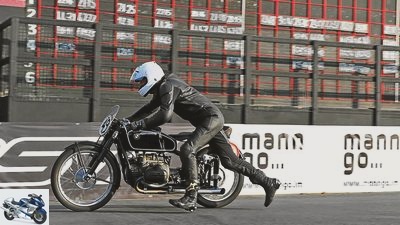
markus-jahn.com
For the photo, Wolfgang Meier, Schorsch Meier’s nephew, simulated sliding starts.
Hopeful young men who felt that they had the talent and saw that they could get the material to get to the top in motorcycle racing. If you became a member of an appropriate organization. Who of us today would have the courage not to seize such an opportunity or to refuse the Hitler salute after a victory in front of thousands of witnesses? I wouldn’t have it. The mistake and the resulting historical guilt of the Germans consists in the fact that, in their political naivety, they did not recognize the totalitarian potential of the NSDAP, but instead allowed it to form a coalition government after a legal election and consequently its position of power against all rights and to expand all humanity.
In the years 1937 to 1939 this power was so consolidated that individual acts of civil disobedience hardly had any effect; only massive, even violent, resistance would have helped. But the masses did not want to oppose at first and later they could not. Why should individuals become martyrs? As for Schorsch Meier, he was with the Bavarian State Police before 1933, which was incorporated into the Wehrmacht in 1936. So he got the rank of sergeant major. He used this rank less to make a career, but more to avoid further career steps in Nazi organizations. He survived the war as a driver for officers, including Erwin Rommel. And there are only a few photos that show him offering the “German greeting”.
Racing 1939: private sector versus state dirigism
The reason given in the English literature for the German TT victory is the fact that Norton, as the strongest opponent of the factory BMW, did not send a factory team to the TT in 1939 because the company was busy building military machines. After all, the Norton aces, last year’s winner Harold Daniell, Freddy Frith and John White received 1938 factory machines. However, they were traveling much slower than in the previous year, which was apparently due to unfavorable wind conditions. While the British companies financed their racing activities themselves, the development of racing machines from BMW, DKW and NSU was subsidized by the state, especially in the years 1933 to 1936. Using files from the Federal Archives, the historian Frank Steinbeck has calculated that the state’s share in the Overall development was around 25 percent.
When the funds were cut sharply from 1937, the quota at DKW was 11 percent. As the presentation of the notoriously unreliable NSU at the TT 1939 shows, subsidies alone did not lead to success. The fact that the technology of the BMW proved to be just as superior as it was mature is primarily thanks to Josef “Sepp” Hopf. The former head of the BMW archive, Peter Zollner, knew him personally and describes his intellect as a seldom happy amalgamation of genius and meticulousness.
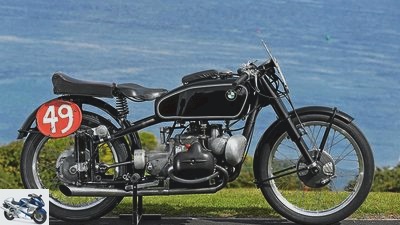
markus-jahn.com
Details such as rims and handlebar fittings are no longer original.
Supported by chief developer Rudolf Schleicher, the trained shoemaker advanced from an auxiliary fitter to an engineer at BMW. He developed the special compressor for BMW engines, the movable blades of which were guided by two lateral, so-called cup disks, and were protected from getting caught in the housing or in its guide and breaking. Deliberately deceiving the competition, the press kit for the TT states that the compressor is designed according to the Zoller principle. When the British BMW importer received a Type 255 machine for a motorcycle exhibition, the technicians were curious about the compressor. They unscrewed the case, but found only a note left by Hopf with the words: “You were not allowed to look in here.”
As Hopf’s accurate test stand protocols show, he tried out every aspect of compressor technology and found the optimal shape and length of the feed pipes in a long series of tests. In addition, the factory BMWs were by far the lightest motorcycles and with the light, oil-damped telescopic fork and the precisely guided rear suspension, they also had the best chassis. Two other important reasons for Schorsch Meier’s victory are also far removed from the world political front lines. The motorcycle historian Stefan Knittel emphasizes that Schorsch Meier was one of the best trained drivers of his time. His excellent condition helped him to survive two hours, 57 minutes and 19 seconds with full concentration at the racing pace.
In 1938, Meier failed after a few hundred meters
Although Meier missed Harold Daniell’s lap record from 1938, he undercut his racing time by 31 seconds. Let’s not forget that Meier still had an open account with the TT. In 1938 it failed after a few hundred meters because one of the warm-up spark plugs had seized up and the thread was so badly damaged when the spark plug had to be replaced by force that it could not hold the newly screwed in racing plug.
This failure has enormously increased Schorsch Meier’s determination, and it was not diminished by the fatal training accident of his teammate Karl Gall. So he did what every good racing driver does: he drove as fast as he could. Under no circumstances did he win the Senior TT with the means with which the Wehrmacht had previously occupied the “remaining Czech Republic” and then attacked Poland.
Jimmy Guthrie and the TT that he could no longer experience
At this point, a man enters the history of the TT of 1939 who could no longer be there. James “Jimmy” Guthrie, the Norton factory driver from Scotland. In 1937 at the GP of Germany on the Sachsenring he had an accident while in the lead shortly before the finish and died in the ambulance after it got stuck in a traffic chaos. Guthrie had taken the physical side of motorcycle racing as seriously as Schorsch Meier; He regularly rode his motorcycle to gymnastics training and photos show his wiry appearance. As the organizer of the German Grand Prix, the NSKK honored Guthrie with an advertisement from Corps Leader Huhnlein in “Das Motorrad” and accompanied the transfer of his corpse with a military guard of honor. One can understand that this martial pomp appeared subtle to some Britons, especially since it did not correspond to Guthrie’s humble nature.
Presumably it did not arise entirely from respect for the great athlete, but also partly from political considerations. In 1937, Hitler solicited the British government’s favor, and British Nazi sympathizers supported Prime Minister Neville Chamberlain’s policies of appeasement. When the Guthrie Memorial was unveiled in 1939, NSKK Obergruppenfuhrer Erwin Kraus and NSU boss Fritz von Falkenhayn stepped forward with swastika armbands and a Hitler salute, which the German drivers also gave. Falkenhayn gave a short speech in German and English, which the audience listened to in silence. This is how Willis describes the ceremony – unfortunately without naming his sources – and in this case, too, the unease about the propagandistic audacity of the German officials is understandable. It is impossible to understand how Jimmy Guthrie’s fate is brought into position against Schorsch Meier’s victory. The impetus for this came from Stanley Woods, who in 1937 parked his Velocette with a broken fuel line near the spot where Guthrie fell.
Damage to the rear axle of his Norton brought Guthrie down
After the race, Woods said that damage to the rear axle of his Norton had brought Guthrie down. Gustav Muller, editor-in-chief of “Das Motorrad”, who apparently spoke to Woods personally, reports this version in his contemporary report. During an interview with British author Mick Woollett in 1992, Woods suddenly accused German DKW driver Kurt Mansfeld of having pushed Jimmy Guthrie off the track.
Apart from the fact that in historical studies those statements are considered to be more credible that are closer to an event in time, i.e. Woods in 1937 is more credible than Woods in 1992, the question arises what all this has to do with Schorsch Meier? Apparently, Roger Willis lacked the courage to complete his revisionist line of argument. Otherwise the final piece would go something like this: Just because the Nazi driver Kurt Mansfeld drove Jimmy Guthrie to his death in 1937, another Nazi driver, Schorsch Meier, was able to win the Senior TT in 1939. If he didn’t mean it that way, the question remains why he gave so much space to the description of Guthrie’s fate in connection with the 1939 TT?
Confusion about the trophy
The story he spread that Schorsch Meier was not allowed to take the large sterling silver trophy with him to Germany in 1939 is verifiably wrong, otherwise it would have been difficult to get it back. The photo of the trophy shown here was taken by BMW in 1939, so the trophy was very likely in Germany. How she got over the war remains unclear; the rumor that Meier hid them in the chicken coop is wrong.
According to Peter Zollner and Fred Jacobs from the BMW archives, it is most likely that it was relocated to the BMW branch in Vienna during the war and handed over to a British occupation officer there in 1947, who brought it back to the island. As the person responsible for the trophies, Lloyd Mister, reports, the return of the silver sculpture Schorsch Meier and BMW is still highly valued today.
Related articles
-
Tourist Trophy Isle of Man 2013
Henniges 34 pictures Henniges 1/34 Everyone on the roadside is excited. Henniges 2/34 The big moment after a journey of several hours: the ferry reaches…
-
Isle of Man: Tourist Trophy, people, nature
Breakers, Werel 20th pictures Breakable 1/20 Laxey Wheel aka Lady Isabella: The largest water wheel in the world is in Laxey. Breakable 2/20 Treat…
-
John McGuinness competes with Norton in the 2018 Tourist Trophy
Norton Sports & scene Motorsport John McGuinness competes with Norton in the 2018 Tourist Trophy McGuinness starts at the TT 2018 with Norton Comeback of…
-
Tourist Trophy: Road racing on the Isle of Man
Davison 37 pictures Motocom 1/37 The Isle of Man Tourist Trophy – the world’s most dangerous motorcycle race. archive 2/37 The Mountain Course is 60.66…
-
Report – Tourist Trophy 2015 on the Isle of Man
Kaschel 30th pictures Borner 1/30 The motorcycles, the drivers, the island, the press: a wild mix at the TT. Michael Dunlop as the title hero on the new…
-
Tourist Trophy 2013 – The bike for the Isle of Man by Horst Saiger
Saiger 8th pictures Davison 1/8 Shortly before the TT, the nervousness of PS racer Horst Saiger increases. Saiger 2/8 Saiger is the reigning Swiss…
-
Isle of Man Tourist Trophy: Electric racing class is canceled
Toni Borner Sports & scene Motorsport Isle of Man Tourist Trophy: Electric racing class is canceled Isle of Man Tourist Trophy Electric racing class is…
-
On the go: The Tourist Trophy on the Isle of Man
Lohse 29 pictures Woollett 1/29 1974: Helmut Dahne in action on the BMW r 75 in the production class; he finished second. Woollett 2/29 1967: Mike…
-
Isle of Man Tourist Trophy 2017
Bernd Fischer 70 pictures Bernd Fischer 1/70 John McGuinness, 23-time TT winner, fanatic and one of the favorites, … Bernd Fischer 2/70 … fell badly…
-
Horst Saiger at the Tourist Trophy
Stephen Bower 11 pictures Bower 1/11 Insider report by Horst Saiger about the TT on the Isle of Man. Bower 2/11 Insider report by Horst Saiger about the…